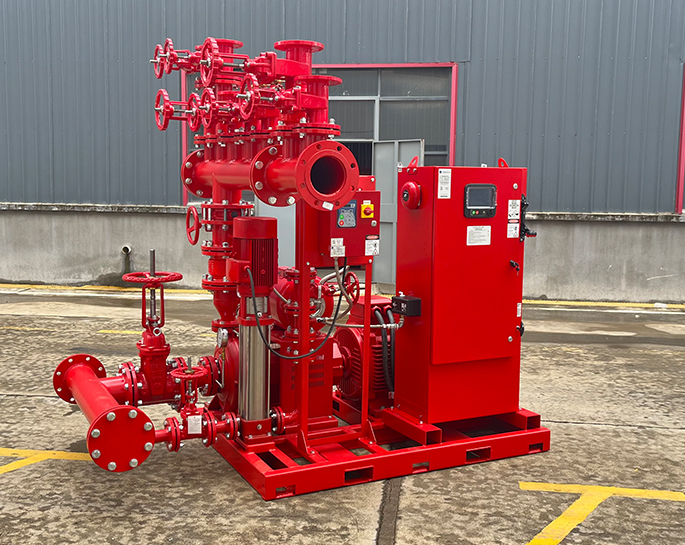What is the impact of water hammer on fire pump systems, and how is it mitigated?
Dec 27, 2023
Share:
Water hammer, also known as hydraulic shock, occurs when there is a sudden change in the flow of water in a pipe, leading to a rapid increase in pressure. In fire pump systems, water hammer can have several negative impacts, including damage to pipes, valves, and other components. Here are some of the potential impacts and ways to mitigate water hammer in fire pump systems:
**Impacts of Water Hammer on Fire Pump Systems:**
1. **Mechanical Stress:** Water hammer can subject pipes, valves, and other system components to sudden and intense pressure changes, leading to mechanical stress and potential damage.
2. **Reduced Pump Efficiency:** Water hammer can cause fluctuations in pressure, leading to reduced efficiency and performance of the fire pump system.
3. **Equipment Damage:** Rapid pressure changes can cause damage to pumps, valves, and other equipment, leading to increased maintenance and repair costs.
4. **Noise and Vibration:** Water hammer events can generate loud noise and vibration in the system, which may be disruptive and cause additional wear and tear on components.
**Mitigation of Water Hammer:**
1. **Slow Valve Closure:** One common cause of water hammer is the sudden closure of valves. To mitigate this, valves can be designed to close more gradually. Slow-closing valves or the use of check valves with anti-slam features can help reduce the impact of water hammer.
2. **Pressure Relief Valves:** Installing pressure relief valves in the system allows excess pressure to be released, preventing sudden pressure spikes. These valves should be set to open at a pressure slightly above the normal operating pressure.
3. **Air Chambers:** Air chambers or surge suppressors can be installed in the piping system. These chambers provide a cushion of air that compresses and absorbs the energy generated by water hammer, helping to reduce pressure surges.
4. **Water Hammer Arrestors:** These devices, also known as shock absorbers, are installed in the piping system to absorb the shock caused by water hammer. They consist of a piston or bladder that compresses in response to pressure changes, helping to mitigate the effects of water hammer.
5. **Proper System Design:** Adequate pipe sizing, layout, and configuration can help minimize the occurrence of water hammer. Avoid sharp bends and use gradual transitions in the piping system to reduce the likelihood of sudden pressure changes.
6. **Check Valve Installation:** Installing check valves correctly can help prevent water from flowing back and causing water hammer. Ensure that check valves are properly sized, oriented, and installed according to manufacturer recommendations.
7. **Monitoring and Maintenance:** Regularly monitor the system for signs of water hammer and perform preventive maintenance to ensure that valves and other components are in good working condition.
8. **Training and Awareness:** Train personnel on the potential risks of water hammer and the importance of proper operating procedures. Awareness can help reduce the likelihood of human error leading to water hammer events.
By implementing these mitigation measures, fire pump systems can be better protected from the negative impacts of water hammer, ensuring reliable and efficient operation during emergencies.

**Impacts of Water Hammer on Fire Pump Systems:**
1. **Mechanical Stress:** Water hammer can subject pipes, valves, and other system components to sudden and intense pressure changes, leading to mechanical stress and potential damage.
2. **Reduced Pump Efficiency:** Water hammer can cause fluctuations in pressure, leading to reduced efficiency and performance of the fire pump system.
3. **Equipment Damage:** Rapid pressure changes can cause damage to pumps, valves, and other equipment, leading to increased maintenance and repair costs.
4. **Noise and Vibration:** Water hammer events can generate loud noise and vibration in the system, which may be disruptive and cause additional wear and tear on components.
**Mitigation of Water Hammer:**
1. **Slow Valve Closure:** One common cause of water hammer is the sudden closure of valves. To mitigate this, valves can be designed to close more gradually. Slow-closing valves or the use of check valves with anti-slam features can help reduce the impact of water hammer.
2. **Pressure Relief Valves:** Installing pressure relief valves in the system allows excess pressure to be released, preventing sudden pressure spikes. These valves should be set to open at a pressure slightly above the normal operating pressure.
3. **Air Chambers:** Air chambers or surge suppressors can be installed in the piping system. These chambers provide a cushion of air that compresses and absorbs the energy generated by water hammer, helping to reduce pressure surges.
4. **Water Hammer Arrestors:** These devices, also known as shock absorbers, are installed in the piping system to absorb the shock caused by water hammer. They consist of a piston or bladder that compresses in response to pressure changes, helping to mitigate the effects of water hammer.
5. **Proper System Design:** Adequate pipe sizing, layout, and configuration can help minimize the occurrence of water hammer. Avoid sharp bends and use gradual transitions in the piping system to reduce the likelihood of sudden pressure changes.
6. **Check Valve Installation:** Installing check valves correctly can help prevent water from flowing back and causing water hammer. Ensure that check valves are properly sized, oriented, and installed according to manufacturer recommendations.
7. **Monitoring and Maintenance:** Regularly monitor the system for signs of water hammer and perform preventive maintenance to ensure that valves and other components are in good working condition.
8. **Training and Awareness:** Train personnel on the potential risks of water hammer and the importance of proper operating procedures. Awareness can help reduce the likelihood of human error leading to water hammer events.
By implementing these mitigation measures, fire pump systems can be better protected from the negative impacts of water hammer, ensuring reliable and efficient operation during emergencies.







